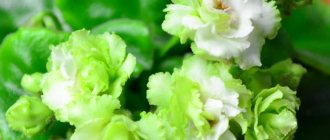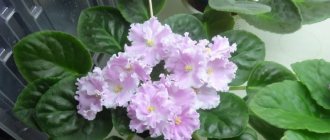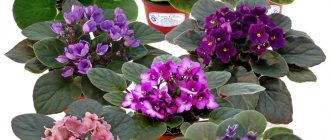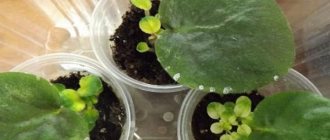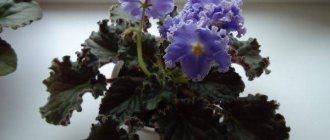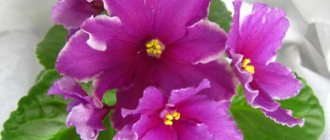Planting and propagation
Before planting, it is important to decide where to place the pot.
It is better to place the violet on the windowsill or nearby . It is advisable to leave it on the north side to avoid direct sunlight. The plant is usually grown from a leaf.
Reproduction usually occurs by stepson, leaf, peduncle and cuttings.
The easiest way is leaf propagation. This process is best started in the spring or summer. It is better to take a leaf from the second or third row; it should be bright green, hold its shape well and be free of damage and stains.
If you root using water, you need to dissolve activated carbon in a disposable glass. After immersing the leaf by 1 cm, place it in a warm place (not in the sun) and after the roots appear about 1 cm, plant it in the soil.
Caring for violets includes watering, replanting and fertilizing; let’s look at each item in more detail.
Watering
The leaves of the plant are located close to the ground. Water should not penetrate their surface and rosette.
To water the violet, you need to immerse the pot in a container of water until the surface of the soil becomes moist.
After the water has drained, the violet is placed in its original place. You need to water twice a week.
Transfer
The plant must be replanted once or twice annually. The best time to do this is in the spring.
Fertilizer and feeding
At the beginning of spring, violets need to be fed with nitrogen fertilizer. When buds form, you need to add phosphorus and potassium fertilizers. You need to do this once every 14 days. You need to buy fertilizers at a flower shop and follow the instructions. In winter, fertilizing is not needed.
Planting after purchase and during propagation
Violet Raisin - description and characteristics of the variety
The violet is replanted 2 weeks after purchase. During this period, she adapts to new conditions of detention. In addition, the florist will be able to identify whether there are any pests or pathogenic microorganisms on the plant.
The transplant is carried out as follows:
- Select a pot 1.5-2 cm larger than the previous one.
- Fill up with loose, fertile soil.
- Remove the violet from the old container along with a lump of earth.
- Plant the plant in a new pot.
- Fill the free space between the roots and the walls of the pot with soil.
Water the violet with warm water. Excess liquid is poured out of the pan.
Violet, description and photo AB-Mother's Heart (Violet Plant)
Violets from breeders of the CIS countries - “C”.
AB-Heart of the Mother (Violetflower).
AV-Mother's Heart, AV-Serdtse Materi (Fialkovod).
Huge wavy contrasting single and semi-double dark purple stars with a white border. The sport AV-Leningradskoe Ice Cream (Fialkovod) - Chimera is assigned to it.
Slightly wavy, medium green leaves. Standard. The socket is compact, small, smooth, neat. Self-forming socket. It remains compact even in adulthood, and does not pull out the petioles of the lower leaves.
Deep burgundy-cherry tone with purple thickening towards the edge of the petals and a thin white edging along the edge. The color of the flower is really dark red-burgundy, velvety. A contrasting white pencil border gives greater clarity of perception and emphasizes the depth of color.
A thin border is present at the beginning of violet flowering, then it stretches over a large flower and is not so noticeable. A very beautiful and rich color when blooming; as the adult flower ages, the color does not fade or fade, but it becomes less bright.
The flowers are very large, up to 8 cm in diameter. Visually, the hat already consists of three or four flowers. Large flowers have been found quite often lately, but on such a compact rosette they are rare. Like most red-flowered plants, there are few buds on the peduncles, but there are many peduncles themselves.
It blooms for more than a month. It blooms constantly and very readily, constantly laying down new flower stalks. Strong short erect peduncles, easily rise above the leaves, but do not rise above the rosette.
The variety is quite easy to grow. It reproduces easily, produces many children, grows and develops quickly. At the initial stage, the stepson is very strong. This variety does not need a lot of light - it clogs the middle. Needs to be kept cool.
From one sheet you can get both sports and complete repetitions of the variety. Sports have light petioles, while varietal ones are pink.
Do you know that…?
Tropical plants need 12-14 hours of daylight to fully develop. Then they will develop well and bloom. This means you need to turn on the backlight a couple of hours before it gets light outside, and turn it off a few hours after it gets dark. It is very convenient to use a relay timer when supplementary lighting or full illumination of plants. Many fluorescent lamp manufacturers offer lamps with a spectrum optimized for plants, but do not go for these specialized lamps, which are much more expensive than regular lamps. It is not necessary to purchase Flora lamps. Install a more powerful lamp with a high color rendering index (lamp marking - /9.). Its spectrum will contain all the necessary components, and it will provide much more light than a special lamp.
Before you buy the violets listed below, carefully read the forums about their behavior on the windowsill. Many of them are very beautiful flowers. However, these can be large rosettes with large and fragile leaves, with leaves rising up or hugging the pot, forming many stepsons that interfere with the formation of a neat rosette, pulling the stem up and growing into a Christmas tree, bending the trunk, rare flowering with long breaks, fallen flowers or they last little and quickly wither, very long and recumbent peduncles, the color of the flower fades quickly, they do not like bright lighting on the windowsill, they are afraid of the slightest drying out or waterlogging, a large percentage of them go into sports or darken the flower.
Are they suitable for your window sill and the conditions that you can create for them? You will look at the flowers for several months, and the rosette will always be in front of your eyes. There are many beautiful flowers, there are much fewer beautiful and neat rosettes, look first at the rosette! Search and you may find a dozen violets with the same flower color if you are not interested in the smallest details as a collector.
• — Happy Birthday (Arkhipov); • — Matchmaker (Lazarenko); • — Svetlana (Makuni); • — Sailor Moon (Zubo); • — Family Holiday (Solodkaya); • — Sergey Yesenin (Violetovod); • — Blue Fog (Prilutskaya); • — Blue Bird (Dadoyan); • — Lilac Charm (Makuni); • — Lilac Whirlwind (Arkhipov); • — Lilac Salute (Arkhipov); • — Glory to Russia (Arkhipov); • — Smaragdove Divo (Volskaya); • — The Old Man and the Seagull (Arkhipov); • — Ancient Castle (Arkhipov);
Rooting a leaf
Next, choose one of two rooting methods: in the ground or in water.
Placing a leaf in water allows you to observe the development of roots, but when planting in the ground it takes some time to adapt.
Rooting in water is done as follows:
- We take water into a disposable cup and dissolve an activated carbon tablet in it;
- We immerse the sheet 1 cm;
- We put it in a warm place, but not in the sun;
- After the roots have formed about 1 cm, we transplant them into the soil.
Violet is rightfully considered one of the most popular indoor plants.
In order for the violet to grow symmetrically, it needs to be turned periodically
When rooting into the ground, we act like this:
- We make small holes in the bottom of a disposable glass to drain moisture;
- Pour in some polystyrene foam for drainage;
- We fall asleep in the ground (recipes above);
- We root the leaf 1 cm;
- Water and keep warm. Possible under film;
- After 1.5 months, new leaves appear.
Violet sprouts with new leaves
When the leaves reach medium size, the violet can be planted in a pot.
How Saintpaulia Le Esmeralda propagates
Violet Fairy - description and characteristics of the variety
Hybrid violet is propagated by cuttings (leaves). They are chosen from the 2nd row. The procedure is carried out as follows:
- Strong cuttings are cut with a sharp knife.
- Place in a glass with a small amount of water.
- When the roots appear, the cuttings are planted in a pot with prepared soil.
Leaves can be planted in a container immediately after cutting. They are slightly dried, then placed ⅓ in the ground. The container with cuttings is covered with film to create greenhouse conditions.
The covering material is removed every day, and the container and it are wiped with a dry cloth. If this condition is not met, the plants may become infected with fungal diseases. Soon, babies will grow from the base of the leaves. They are grown and then transplanted into separate small pots.
After the roots appear, the cuttings are planted in a small pot.
Important! Seed propagation can lead to the appearance of characteristics not stated in the crop description.
What does Esmeralda violet look like?
Violet LE Esmeralda is a delicate, touching flower that does not stand out with particular brightness or splendor. But at the same time, the flowering is abundant, due to which this whole amazing picture is created.
Violet LE Esmeralda
Plant characteristics
Botanical description of Saintpaulia Esmeralda:
- the flower is large, bright crimson in color, with fringe along the edges;
- along the edge of each petal there is a light green edging, which brightens over time;
- leaves of a standard oval shape, slightly tapering towards the end, become wavy over time;
- The color of the edging can be maintained if the room temperature is maintained at a consistently cool temperature.
Interesting! The main feature of this plant is that even the first flowering is very abundant.
Violet Esmeralda belongs to the Gesnerieceae family, genus Saintpaulia Hybrida.
Briefly about the history of appearance
The violet got its name in honor of the famous gypsy from V. Hugo’s novel “Notre Dame de Paris.” The color of its petals and the lace around the edges reminded the breeders working with the variety of this beautiful girl. The variety has several varieties.
The difference between the varieties Esmeralda and Esmerald Lux
LE Esmeralda Lux is one of the varieties of the hybrid. It was bred by breeder Elena Lebetskaya, who became the author of most varieties. This hybrid is characterized by greater terry and petal size. The color saturation is also slightly different. In this case, they are either raspberry-burgundy or fuchsia. The light green border along the edge of the flower remains unchanged throughout the entire flowering period.
Violet Esmeralda Lux
Sports of this type
A sport of violets is considered to be any minor but regularly recurring difference in a number of plants belonging to a given species. These differences may be expressed in the shape of flowers or leaves. Sport Esmeralda is a completely similar plant, the leaves of which are as curly as the flowers. But the color of the delicate petals itself is completely pink.
Esmeralda - sport of violets
Transplanting violets Margaret
Plants require periodic replanting, usually done in the spring. After removing the violet from the pot, you need to carefully remove the old soil from the roots and slightly trim the lower roots without damaging the upper ones. This will be enough until the root system for the outlet is updated.
It is better to use pots that are equal in height and width. For young plants the capacity can be about 4 cm, for large ones about 9 cm. Violets do not like large containers, so you should not dress it in a “growing coat”. The soil mixture for replanting is prepared from deciduous soil, peat and river sand in a ratio of 3:5:1.
Be sure to place drainage at the bottom of the pot, then special soil for violets, you can add a fifth of the volume of vermiculite and perlite to it, and also add crushed sphagnum moss.
Large pots are not suitable for Margaret violet, as the plant will not grow and bloom well in it.
Botanical description of the plant
LE-Esmeralda is the creation of breeder Elena Lebetskaya, which explains the initial part of the variety’s name. The rich color of the petals and foliage of the plant creates an atmosphere of luxury and celebration, so the author associated the bred flower with a precious semi-precious mineral (translated from Spanish, the word “esmeralda” means “emerald”). The beauty and capriciousness of the culture is motivated by its association with Victor Hugo's Esmeralda from Notre Dame.
This violet blooms for a long time, of a bouquet-cap type. Despite the fact that the variety fully opens only after 2–3 buddings, the first set of peduncles is quite abundant.
Important! In floriculture, there is another variety of the RS-Esmeralda variety, bred by breeder Svetlana Repkina. Its flowers are characterized by their large size (can reach 7 cm in diameter) and a snowy edging on the edge of the petals.
The color of the buds of this author's plant is more saturated inside than at the edges.
The flowers are large and bright, double or semi-double, with rich shades of ripe raspberries. The uniqueness of the variety lies in the unusual white-green edging of the petals. The distinct carved shape harmoniously combines with the light green edging of the upper skirt and the green edging of the lower one. As the bud opens, the ruffles lighten, but never become pure white. If you keep the flowerpot in a cool room, the color of the border will be more vibrant.
The flowering period of a crop depends on its growing conditions and time of year. For example, in the cold season, violets can bloom from 3 to 6 months. In the final phase, it is possible that the buds that have not yet opened will wither. With the onset of warmth, vegetative processes become more active. The instability of the variety is noted: it is almost impossible to find 2 rosettes with identical flowering. As the violet fades, it loses its color saturation.
Important! Unlimited illumination of violets with fluorescent lamps leads to the appearance of red spots on the foliage
What the plant looks like: photo and description of the variety
Saintpaulia has large double or semi-double flowers of a deep crimson hue. The LE-Esmeralda violet differs from other varieties in its green edging, which, as the bud opens, brightens on top, but never turns white, and remains green below; if the temperature is kept cool, the edging will not change color.
The leaves are velvety, uniformly green in color, not curly. At the base they are collected into a neat rosette; as they age, they acquire a slight waviness.
The main difference of the variety is that even the first flowering lasts a long time and produces many flowers, creating a large lush head. Esmeralda is unstable; 1 rosette does not produce identical inflorescences. It can bloom in winter, but the bud takes a long time to open and eventually dies.
There is another type of this variety - this is RS-Esmeralda, bred by breeder Svetlana Repkina. The flowers of this violet can reach 7 cm in diameter, their edges are white, and the color is more saturated towards the center.
Le Esmeralda Lux
An even, moderately green rosette, the leaves are large and slightly wavy. The flowers are large, crimson, burgundy, fuchsia with a white and green skirt. As the bud blooms, the ruffle turns white, but in the cold it can retain its green color.
Bouquet, long-lasting flowering, the violet reveals all its beauty already in the first flower. The peculiarity of violets of this variety is that one plant can bloom in different ways. Photos and descriptions of the variety can be seen above.
Le Esmeralda sport
In appearance, the Esmeralda sport violet is similar to its relative, its main difference from the luxury variety is the foliage, it is curly on the plant.
Violet, description and photo LE-Esmeralda (E. Lebetskaya)
Violets from breeders of the CIS countries - “E,Yu” (LE).
LE-Esmeralda (E. Lebetskaya).
LE-Esmeralda (E. Lebetskaya).
Large bright semi-double and double burgundy-raspberry-fuchsia stars with darkening along the edge of the petals and a ruffled white-greenish ruffle.
Smooth medium green slightly wavy rosette. Standard. The socket is extremely neat and even.
Large bright fuchsia-burgundy semi-double stars with a clear green ruffle. There is a white edging on the upper skirt, and a green ruffle on the lower one, the border on the flowers is carved and distinct. The flowers are large, bloom with a green border; as the size of the flower increases, the border becomes white, one might say with a light green tint. If it's cool, the green border may remain. The green ruffle appeared only on the second flowering.
Flowering cap. I planted a lot of flower stalks right away, during the first flowering. The variety opens only by the second or third flowering. Bright large flowers, perfect rosette, bouquet flowering. The violet has been blooming non-stop for three months now. Over time, the flowers fade.
Not capricious, tenacious, growing quickly, forms a good rosette. A rather unstable variety, it is almost impossible to find 2 rosettes with the same flowering, moreover, the same plant can bloom differently at different times of the year.
In cold weather, flower stalks can open from 3 to 6 months, but the flowers fade without fully blooming. As the weather warms up, the flowers begin to open faster. Under artificial light, red spots may appear along the edges of the leaves.
The leaves should be slightly wavy. If the leaves are wavy, then this is a sport according to the variety; Esmeralda does not have curly leaves. The sport is immediately recognizable as it has highly wavy, curly leaves.
Esmeralda (Spanish: “Emerald”) is a female name, etymologically and semantically comparable to the Arabic name Zumrud. The main character of Victor Hugo's novel “Notre Dame de Paris,” as well as films, plays, musicals, and ballets based on the novel.
Do you know that…?
Plain or Tailored is the most common leaf, simple in shape and texture, often called standard or boy leaf. Violet foliage has smooth edges, without noticeable relief of the leaf plate. In varieties of the boy-leaf group, the leaves are completely green. The vast majority of Saintpaulias have such foliage.
Before you buy the violets listed below, carefully read the forums about their behavior on the windowsill. Many of them are very beautiful flowers. However, these can be large rosettes with large and fragile leaves, with leaves rising up or hugging the pot, forming many stepsons that interfere with the formation of a neat rosette, pulling the stem up and growing into a Christmas tree, bending the trunk, rare flowering with long breaks, fallen flowers or they last little and quickly wither, very long and recumbent peduncles, the color of the flower fades quickly, they do not like bright lighting on the windowsill, they are afraid of the slightest drying out or waterlogging, a large percentage of them go into sports or darken the flower.
Are they suitable for your window sill and the conditions that you can create for them? You will look at the flowers for several months, and the rosette will always be in front of your eyes. There are many beautiful flowers, there are much fewer beautiful and neat rosettes, look first at the rosette! Search and you may find a dozen violets with the same flower color if you are not interested in the smallest details as a collector.
•— Exclusive (Korshunova); •— Emmanuel (Prilutskaya); •— Esther (Lebetskaya);
•— Julia (Lebetskaya); •— Young Spring (Lebetskaya); •— Young Witch (Korshunova); •— Juno (Pugacheva); •— Jupiter (Makuni);
•—Apples (Lebetskaya); •— Java Moss (Violet Plant); •— Japanese Spring (Sergeeva); •— Yaroslavl (Korshunova);
Diseases and pests
If signs of violet disease appear, this can only mean one thing - the plant was not cared for correctly. As a result, various diseases may appear.
Powdery mildew
This disease manifests itself as a result of excessive moisture or low temperature. White spots appear over the entire surface of the leaves. For preventive purposes, violets should be treated with sulfur powder or any fungicide.
Late blight
This disease immediately affects both the stems of the violet and its root system, which acquires a grayish-brown tint. In order to get rid of it, you need to remove the plant from the flowerpot and cut off all the affected roots.
Then it must be transplanted into a new container with fresh substrate.
Gray rot
When a fluffy gray coating appears on a violet, this can lead to the rapid death of the entire plant. At the first signs, it must be transplanted into fresh soil, having previously treated the entire root system with calcium.
Fusarium
This disease appears as a result of sudden temperature changes, or when the container does not match the size of the plant. The roots of the violet immediately begin to rot, as well as the leaves. Fusarium can only be treated with antifungal drugs.
Rust
Rust can appear on a plant only as a result of water getting on the leaves. However, to combat it, it will be enough to simply cut off the affected parts of the violet.
Don’t forget about pests, which also need to be controlled.
Nematodes
Often small worms may appear in the substrate, which cannot be immediately noticed. They take all the juices from the violet, releasing a lot of toxins. Spots immediately appear on the leaves, which after a certain time simply rot. A little later, the entire plant disappears. In this case, it will not be possible to cure Saintpaulia; you just need to destroy it and treat the pot with a disinfectant solution.
Whiteflies
These pests settle on the lower leaves of the violet and entangle it in a sticky web. You can fight it with the help of special drugs, for example, “Actofit” or “Fitoverma”.
Ticks
Such pests most often affect young leaves, which turn gray. In addition, the buds also do not open.
The fight consists of treating the plant with chemicals.
To summarize, we can say that “Esmeralda” differs from its relatives in its rather bright and lush flowers. And if you care for her correctly, she will be able to delight you with this beauty for quite a long time.
For information on how to plant violet “babies”, see below.
How to grow it correctly?
In order for Saintpaulia to grow into a beautiful and healthy flower, it needs to create all the necessary conditions.
Where is the best place to place it?
Like any violet, this variety loves light, so it is better to place the flower on the western or eastern side of the room. This way there will be enough lighting and it will be gentle. Avoid direct exposure to sunlight, as this can cause leaf burns.
Priming
The soil for the plant should be loose, contain coniferous, leaf and peat soil
Florists pay attention to acidity, high mineral content, lightness, air tightness, and moisture capacity. Nitrogen content should be in moderation
Pot
Another important detail is the choice of pot for the indoor plant; it should be made of clay or plastic. The diameter of the rosette should be 3 times larger than the upper circumference of the flowerpot, and the height should be equal to the circumference of the pot
Watering
Many inexperienced gardeners encounter violet diseases associated with improper watering. Since the lower leaves grow very close to the ground, and water can get on the base or surface of the leaf, top watering is not suitable for the plant.
For Esmeralda, this method is only appropriate if you need to wash off the salts formed from hard water around the edges of the pot.
Bottom watering is correct for the plant. The pots are lowered into water until the top layer of soil becomes moist. After the excess water has drained off the flower, you can put it back in place.
Some gardeners use the string method; they string a string through the top into the bottom hole of the flowerpot and lower it into a container of water. It is believed that this way moisture is absorbed better and faster.
Light
Saintpaulia is not a very whimsical plant, but each variety has its own characteristics. Esmeralda is an active flower and blooms for a long time, so it needs a lot of light, up to 14 hours a day; if there is insufficient lighting on the windowsill, it can be supplemented with artificial lighting.
Humidity
The indoor flower loves moist air, but it is forbidden to spray it, because its leaves begin to become sore when exposed to water. To provide moist air, some breeders wash the foliage with a shower, but do not forget that they must be wiped dry afterwards.
You can simply wipe off dust with a damp cloth. Such water procedures should be carried out no more than once a month.
Other plant breeders install a drain with pebbles and water near the flower, or alternatively use perlite. All these methods will help create the proper conditions and prevent the occurrence of fungal diseases.
Temperature
Temperature conditions are also important for Esmeralda; during the day the air should be warmed up by +18°...+24°C, and the night temperature should be 4°C lower than the daytime temperature.
Too sudden temperature changes have a detrimental effect on the plant or lead to its disease; you should also not create drafts or sultry heat.
Features of care
Violet Blue Dragon - description and characteristics of the variety
Violet Le Esmeralda is capricious, but with proper maintenance it blooms beautifully and for a long time. The most favorable temperature for it is +18-22 degrees. You should not take the plant out into the air in the summer. It is important to prevent differences between day and night temperatures.
Place pots of violets on a western or eastern window. The leaves should not be exposed to direct sunlight, as this may cause burns. In hot weather, plants are moved away from the glass. Daylight hours should be long and at least 15 hours a day. In winter, the crop is illuminated using phytolamps.
Bottom watering of violets
Water the violet as the top layer of soil dries. Use warm, settled water. A few minutes after watering, excess liquid is removed from the pan.
Note! Violet prefers bottom watering from a tray.
Saintpaulias are not sprayed. Drops of water on leaves cause yellow spots to appear. As a result, the decorative value of the crop is significantly reduced.
Le Esmeralda does not tolerate dry air well. To increase the humidity levels, water is sprayed from a spray bottle around the violet. In addition, plants can be placed in a tray filled with wet expanded clay.
Priming
The substrate for violets is selected to be light, air- and water-permeable. At a flower shop you can purchase ready-made soil for Gesneria crops. You can prepare it yourself from the following ingredients:
- leaf soil;
- peat;
- river sand;
- perlite
Pieces of charcoal can be added to the disinfection substrate.
Esmeralda inflorescences
Feeding
When planting Saintpaulia in fertile soil, the first fertilizing is done after six months. First, nitrogen is added to promote the growth of green mass. During the period of bud formation, potassium-phosphorus fertilizers are applied. They promote lush flowering.
Note! Fertilizers should be applied to pre-moistened soil.
Location, lighting and humidity
All flowers require good conditions for their cultivation. Violets of any variety need a well-lit place. However, we should not forget that flowers, including the “Margaret” variety, can die from direct sunlight and the burns they leave on the leaves.
If you have a lot of violets, it is better to equip them with special racks with artificial lighting. Flowers of this species need 12 hours of full light to produce the hormones it needs.
The best place to place them is windows that face east and west. South-facing windows should be shaded with parchment paper or mosquito netting to create diffused light.
In winter, it is better to remove violets away from heating systems and additionally humidify the air, as it becomes dry, which can destroy these plants. 60–70% humidity is recommended for them.
Margaret's violet should not be placed on southern windows - direct sunlight will leave severe burns on the plant.
Temperature
Drafts are contraindicated for the plant; if they are overcooled, their leaves will curl; if they are overheated, on the contrary, rotting may begin. The most suitable temperature for this species is 17-20⁰ C.
At an acceptable cool temperature and good humidity, the characteristics of the “Margaret” variety appear - the color becomes rich and bright, the rosettes develop densely.
Organization of watering
Many people make the mistake of believing that violets prefer constant moisture. In fact, they can be watered only after the top layer of soil has dried, that is, as needed. You should not spray them - water on the leaves under the influence of the sun causes burns on these plants.
The pot should not be allowed to dry out or become flooded; this can cause a number of diseases in the plants. You need to water with lukewarm melted or settled water and preferably through a tray. A description and photo of the process will help you avoid a number of problems associated with watering.
Feeding violets Margaret
Margaret violet, like other flowers of this species, require year-round feeding. You should not use universal fertilizers; be sure to use fertilizers only for flowering plants. In winter there is enough organic matter; minerals are needed more in the autumn-spring periods. During the formation of inflorescences, phosphorus is needed, thanks to it the flowers become larger and more colorful.
Features of feeding:
It is better to halve the norm indicated on the fertilizer package. Violets need fertilizers that were developed taking into account their characteristics, but you still need to observe the measure: plants will not bloom with excess nitrogen, stepsons and leaves will form intensively, excess potassium can cause yellowing and stunting. growth. It is better to make the feeding concentration 2 times less than what is written on the package (it is better not to feed the violet more than to overfeed it). It is important to choose a complex fertilizer that corresponds to the stage of plant development, and change them from time to time. For the development of rosettes and leaves, young specimens need more nitrogen. For rich flowering and bud formation, add phosphorus. Potassium will prolong the flowering period. Do not allow solutions to get on the leaves. Feed only after watering and only healthy plants. Do not fertilize in bright sun and after transplantation.
Conditions for growing at home
Despite the widespread popularity of violets, many gardeners are faced with uncertainties in their cultivation. Based on this, we will analyze in detail all the requirements of a flower for comfortable development.
Lighting
To speed up the planting and opening of buds, it is advisable to place the flowerpot in a well-lit place, covering it from direct sunlight.
Rapid growth and active flowering of LE-Esmeralda are ensured with a 14-hour daylight hours. Therefore, additional lighting is appropriate in winter.
Temperature
Both a draft and high temperature in a hot summer can destroy a flower. To avoid unfavorable factors, it is important to control the daytime temperature at +20…+ 24 °C year-round. At night, it is permissible to lower the thermometer by only 4 degrees compared to daytime readings.
Air humidity
Violets react painfully to foliage spraying, but they love moist air. Therefore, in order to provide them with comfortable conditions and prevent the development of fungal infections, you need to place a vessel with pebbles and water near the flower pot. Other gardeners recommend a container with wet perlite as an alternative. It would not be superfluous to wash the leaf plates monthly; this is done with a damp cloth. This procedure can be done in the shower, but afterwards you must remove excess moisture.
Did you know? Many peoples consider the violet to be a sacred flower. That is why the ancient Greeks decorated their homes and statues of the gods with its buds; the Gauls showered the newlyweds with petals, and the French had a golden violet as their highest award in Toulouse poetry tournaments.
Home care
Competent agricultural technology for growing violets of any type involves regular watering, fertilizers and timely replanting. Some varieties require anti-aging pruning. Let us consider in more detail to what extent and how often these procedures are relevant for LE-Esmeralda.
Watering
Beginning flower growers often encounter violet diseases resulting from improper watering. The fact is that their leaf rosette is placed low near the ground, and the moisture accumulated on the fleecy surface of the foliage evaporates for a long time, thereby provoking the emergence of a pathogenic environment. Therefore, it is extremely undesirable to water the flowerpot at the root.
Surface watering for LE-Esmeralda is only appropriate if you use a watering can with a long narrow spout. When moistening the soil in a pot in this way, you need to make sure that drops of water do not fall on the leaves or in the center of the rosette.
The procedure is carried out carefully and without haste until moisture seeps from the drainage holes of the flowerpot into the pan. According to experts, top watering helps flush out salts accumulated on the edges of the pot, the appearance of which is caused by hard water
The violet needs to be watered from below. To do this, just immerse the flowerpot in a container of water. After moisture appears on the surface of the soil, the flower can be removed from the pan. After waiting for the water to drain, the pot is returned to its old place. Some housewives advise moistening the substrate in a pot using the lace method. Its essence lies in a rope specially provided during planting, which is passed through the drainage hole on top of the pot. With this device, when the pot is placed in a vessel with water, the substrate quickly absorbs moisture.
Top dressing
Fertilizers for this crop are relevant only during the growing season.
They are introduced (depending on the phases of development) according to the following scheme:
- In early spring, nitrogen-containing substances are added to the water to moisten the substrate;
- During the formation of buds, phosphorus-potassium fertilizers are applied every 2 weeks.
Trimming
Chaotic removal of leaves reduces the decorative value of violets. Ignorant pruning negatively affects flowering times and provokes the death of the root system. The fact is that flower stalks are laid in the leaf axils. By cutting them, you disrupt the flowering phase and provoke disruptions in the biochemical processes of the plant, thereby shortening its life. Therefore, it is strictly prohibited to get rid of excess vegetation on a violet bush in this way.
The problem can be solved by replanting the flowerpot, deepening the unsightly place into the substrate. Other flower growers advise cutting off the top of the bush so that a stump 1 cm high remains under the leaves. It is dipped in a container with an aqueous solution of a growth stimulator for several days and after the roots appear, it is planted in a new pot.
It is also important to cut off faded flower stalks and damaged parts of the plant as necessary.
Transfer
The LE-Esmeralda violet needs to be replanted annually. In case of fungal infections, the flowerpot is subjected to this procedure as necessary. It is better to do it in the spring.
For replanting, you will need a light, loose substrate consisting of equal parts of peat, deciduous and coniferous soil.
It is important that this mixture absorbs moisture well, is airtight, and its acidity level corresponds to pH 5.5 - 6.5. In addition, it is recommended to monitor the amount of nitrogen and phosphorus-potassium substances contained
If the proportion of the first ingredients should be moderate, then the second need not be limited.
Experts recommend clay and ceramic products because they allow the roots to breathe, which is of particular importance for a full growing season. However, all violets and Saintpaulias (varieties of violets) are characterized by increased vitality, so they are often rooted in plastic pots.
The process of replanting a flowerpot is carried out by transferring a heavily moistened earthen clod into a new container. Sprinkle fresh soil on top. If the crop is old (and also in the absence of replanting for a long time - more than 2 years), the replanting soil must be completely replaced.
Reproduction
To get a new LE-Esmeralda seedling, you will need an ordinary leaf, peduncle, stepson or cutting. The easiest way to propagate violets is leaf violets. It is best to practice it in spring or summer. For planting, a well-developed leaf of 2 or 3 rosette rows is prepared
It is important that it is not damaged and holds its shape and color well.
Care
Violet is one of everyone's favorite flowers that grows at home. There are a large number of species and subspecies, each beautiful in its own way. In order for the plant to constantly please, it needs to be provided with the proper conditions.
Proper care of violets includes not only lighting, temperature, location, but also propagation, replanting, fertilizing, and preventing diseases and pests.
Reproduction
Most often, propagation occurs by leaf - this is the most common method. The leaf is taken from the 2nd or 3rd row; it should be undamaged, keep its shape, and have a bright green color.
Once a leaf is selected, it needs to be rooted. This is done in a disposable glass with water in which activated carbon is dissolved.
You need to lower the leaf there by 1 cm and place it in a warm place, but not in the sun. It is preferable to leave it on the north side. Once the roots appear, the shoot can be planted.
There are other methods of propagation: by daughter rosettes, cuttings, and rarely by seeds.
Transfer
Esmeralda is replanted once a year in the spring or as needed. For replanting, choose light, loose soil consisting of coniferous, deciduous, and peat soil. Be sure to look at the mineral content and acidity level.
When replanting, carefully select a pot; it should be 3 times smaller than the diameter of the rosette; experienced gardeners recommend clay flowerpots, this has a beneficial effect on the growing season; they are often rooted in plastic flower pots.
As soon as everything is prepared, the moistened soil along with the flower is taken out of the pot and, by transferring it, transferred to another, supplemented with fresh soil. If the plant has not been replanted for more than 2 years or the violet is old, the soil is completely replaced.
Application of fertilizers
Fertilizers are necessary for Esmeralda in the spring and during the period of bud formation. Use fertilizing every 2 weeks, except in winter. In winter, the flower is dormant, does not grow or bloom.
At the very beginning of spring, nitrogen fertilizers are used, and phosphorus is introduced from the moment the flowers form. All fertilizers can be purchased ready-made in flower shops; they are used according to the attached instructions.
Prevention of diseases and pests
Festering, fungi, spots on the foliage, violation of the integrity of the rosette, problems with flowering, all these are the consequences of improper care.
Below are the main diseases and pests that breeders most often encounter:
- Powdery mildew - its appearance is caused by high humidity and too low a temperature; it manifests itself as a white coating. Prevention of treatment is carried out with fungicidal preparations or sulfur powder.
- Late blight - affects the stems and roots of Saintpaulia, they become gray-brown. In order to cure it, you need to remove the violet from the pot, cut off the roots affected by the disease and plant it in fresh soil in a new pot.
- Fusarium is a disease manifested by rotting roots and leaf petioles. These are the consequences of improper care. Watering with cold water, sudden temperature changes, too large a pot. Treated with antifungal drugs.
- Gray rot is a gray fluffy coating that leads to the immediate death of the plant. The reason for its appearance is improper care. In order to cure a violet, it is necessary to transplant it into clean soil and treat the root system with calcium permanganate.
- Rust - is formed from water getting on the leaves and flowers of Saintpaulia. The treatment is quite simple: remove the irritant and cut off the damaged parts.
- Pests like scale insects, whiteflies, and spider mites are also not spared; insecticides will come to the rescue here.
Esmeralda differs from other Saintpaulias in its brightness and lush flowering. If she is provided with all the conditions for life, she will certainly thank you with beautiful, lush flowers that will delight the eye for a long time.
Possible diseases, pests and methods of combating them
Violet is often susceptible to various diseases, so you should be careful about the plant. The same improper watering can lead to root collar rot. In addition, there will be a threat of infection of neighboring plants.
If you find signs of powdery mildew or gray rot on violets, which is expressed by the appearance of mold on the leaves, you need to urgently remove the affected areas of the flower and treat the remaining ones with special products. It is strictly forbidden to water the plant in such cases.
Violets look terrible if they are infested with insects such as mealybugs, nematodes and cyclamen mites. Plants begin to lag in growth, lose buds, change color and leaves become deformed.
In this case, a complete transplant with a change of soil and container is recommended. It is necessary to remove all affected parts and treat with insecticides - chemicals to kill harmful insects.
Violet can be attacked by various pests.
Possible problems during cultivation
Due to improper care, the decorative value of the flower may decrease. Drops of water falling on the leaf plates provoke the appearance of yellow spots. Due to lack of light, the cuttings are stretched. Due to the heat, the leaves may begin to dry out.
The appearance of insects weakens the plant and leads to loss of decorative appearance.
Pests and diseases
If the violet is kept in a room with too dry air, it may be attacked by spider mites. In addition, Saintpaulia is affected by thrips and aphids. Insects are eliminated using insecticides.
Common diseases of Esmeralda violet:
- powdery mildew;
- rust;
- root rot.
Fungicides are used to prevent and treat Saintpaulia.
Signs of improper care
Esmeralda is a capricious violet, so it is better for beginners to practice on more unpretentious varieties. Signs of improper care of Saintpaulia are as follows:
- due to lack of light, the petioles become elongated;
- Soil salinity causes leaves to curl;
- Watering with cold water, spraying, exposure to direct sunlight contributes to the appearance of various spots on the leaves.
Esmeralda is a violet variety with beautiful crimson inflorescences. She is a little capricious, so she requires careful care. But by correctly performing agrotechnical measures, the gardener will be able to grow a spectacular houseplant on his windowsill.
Indoor violet - description
Indoor violet is a herbaceous perennial plant. It has an underdeveloped fibrous root system and fleshy stems. Depending on the species, the stems can be short, with leaves growing at the roots and forming a rosette, or elongated, branching with a large number of hanging rosettes. The diameter of the stem can range from 6 to 60 centimeters in length.
The leaves are round, elongated or ovate. The base is heart-shaped or simple. The tip is rounded or sharp. The edges are light, slightly rounded or coarsely serrated. The leaves are flat, highly corrugated, slightly wavy or curved in one direction or another.
The leaves are green in color, sometimes with silver or golden hues. Sometimes there are olive, salad, cream, yellow or pink areas on the leaves. Multi-colored areas are located along the edges of the sheet, at the base, or form various patterns. The inner side of the leaf is usually silvery-green, sometimes with a red tint.
